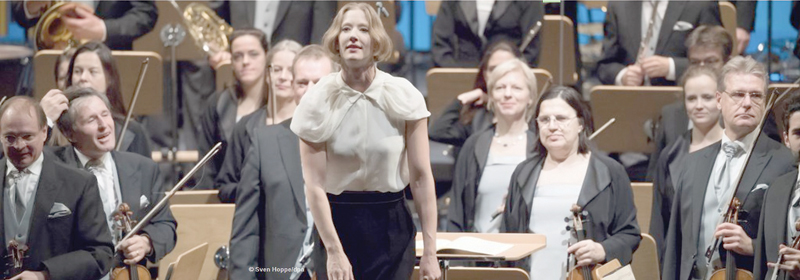

Female conductors are finally rising through the orchestral ranks
Georg Etscheit -
When Mexican conductor Alondra de la Parra made her debut at the Mozart Week music festival in Austria in January 2019, the critics were full of praise. Germany’s Sueddeutsche Zeitung described her as a “charismatic conductor” and wondered how long it would be before she was snapped up by a German record label. The 38-year-old, known for her impulsive, physical conducting style, is currently music director of the Queensland Symphony Orchestra in Brisbane, Australia.
And she is one of a growing number of ambitious women gracing the world’s podiums.
Only a decade ago, examples of female conductors were few and far between, with a few notable exceptions: Australian Simone Young, then general music director of the Hamburg State Opera; and American Marin Alsop, then head of the Baltimore Symphony Orchestra.
Since then, women have made great strides in the music world and now occupy a significant number of top classical music positions worldwide.
Is one of the final bastions of masculinity in the music world finally starting to fall?
“Can a woman conduct Wagner? Isn’t it too tiring?” Joana Mallwitz has been asked this question many times. The answer, as she has proved, is yes: Mallwitz has conducted “The Flying Dutchman” in Copenhagen and “Das Rheingold” and “Goetterdaemmerung” at the Latvian National Opera in Riga.
In the German city of Erfurt, where she was the youngest music director in Europe, she conducted “Die Meistersinger von Nuernberg.”
More recently, as general music director of the Nuremberg State Theatre, she conducted a production of Prokofiev’s monumental operatic drama “War and Peace.”
The Wuppertal Symphony Orchestra also currently has a woman at the helm — British conductor Julia Jones — as does the New Lausitz Philharmonic Orchestra with Ewa Strusinska from Poland.
Ukrainian Oksana Lyniv, a protegee of soon-to-be Berlin Philharmonic chief conductor Kirill Petrenko, was until recently in charge at the Graz Opera. She’s now decided to carve out a freelance career — and is tipped to become a big name in the music world.
Alsop, meanwhile, will become the new chief conductor of the Vienna Radio Symphony Orchestra in September — the first woman to hold the position.
And then there’s the American Karina Canellakis, soon-to-be chief conductor of the Netherlands’ Radio Filharmonisch Orkest; Lithuanian Mirga Grazinyte-Tyla, who succeeded Andris Nelsons as music director of the ensemble that launched Simon Rattle’s career, the City of Birmingham Symphony Orchestra; and last but not least, American Karen Kamensek, who was general music director of the Hanover State Opera until the 2015/16 season and is now a successful freelance conductor.
Things have changed a lot over the past 10-20 years, according to Mallwitz — especially when it comes to attitudes.
One reason for that, she believes, is the growing influence of the early music scene, where ensembles have a less hierarchical structure. Early music groups are often led not by an authoritarian conductor on a podium, but by a fellow player — such as the Austrian cellist and conductor Nikolaus Harnoncourt, who died in 2016.
Harnoncourt began his career as a cellist with the Vienna Symphony Orchestra before founding the Concentus Musicus Wien chamber ensemble and later becoming a regular guest conductor at the Vienna Philharmonic and the Salzburg Festival.
“Women could do that too,” says Mallwitz, who also worked as the leader of her own ensemble, Ochsentour, on her path to becoming a general music director.
You only have to look at the proportion of women studying conducting in music conservatoires to see that something is changing.
In Germany’s music colleges, in the 2016/17 winter semester, 42 per cent of those studying conducting were women. Ten years ago, that figure was just 27 per cent.
However, the proportion of women heading Germany’s 130 professional orchestras is still much lower than that.
Meanwhile, big music institutions like the Salzburg Festival are increasingly being asked to explain why they are not showcasing more female conductors.
When recently faced with this question, Markus Hinterhaeuser, general director of the festival, said he was sure there would soon be more women on the podium: “I must have the feeling that I have found an ideal artistic constellation,” he said. “That is not something gender-specific.”
The times of “active suppression of women in creative professions,” as Niko Kerber of the Archive of Women in Music in Frankfurt puts it, seem to be coming to an end.
And that’s something the old guard are also having to accept — such as Mariss Jansons of the Bavarian Radio Symphony Orchestra, 76, who was forced to apologize in 2017 after he described women on the podium as “not my cup of tea.”
Due to his advanced years, he said, he had merely wished to express that female conductors were something he was unaccustomed to. He was forgiven.
A lot of water may still have to flow through the Blue Danube before a woman gets the chance to conduct the legendary Vienna Philharmonic New Year’s Concert.
But the taboo has already been broken at the equally conservative Vienna State Opera Ball — in 2017, Italian Speranza Scappucci stood in for an indisposed Semyon Bychkov, albeit wearing a conservative black trouser suit rather than a feminine ball gown. — dpa
Oman Observer is now on the WhatsApp channel. Click here



